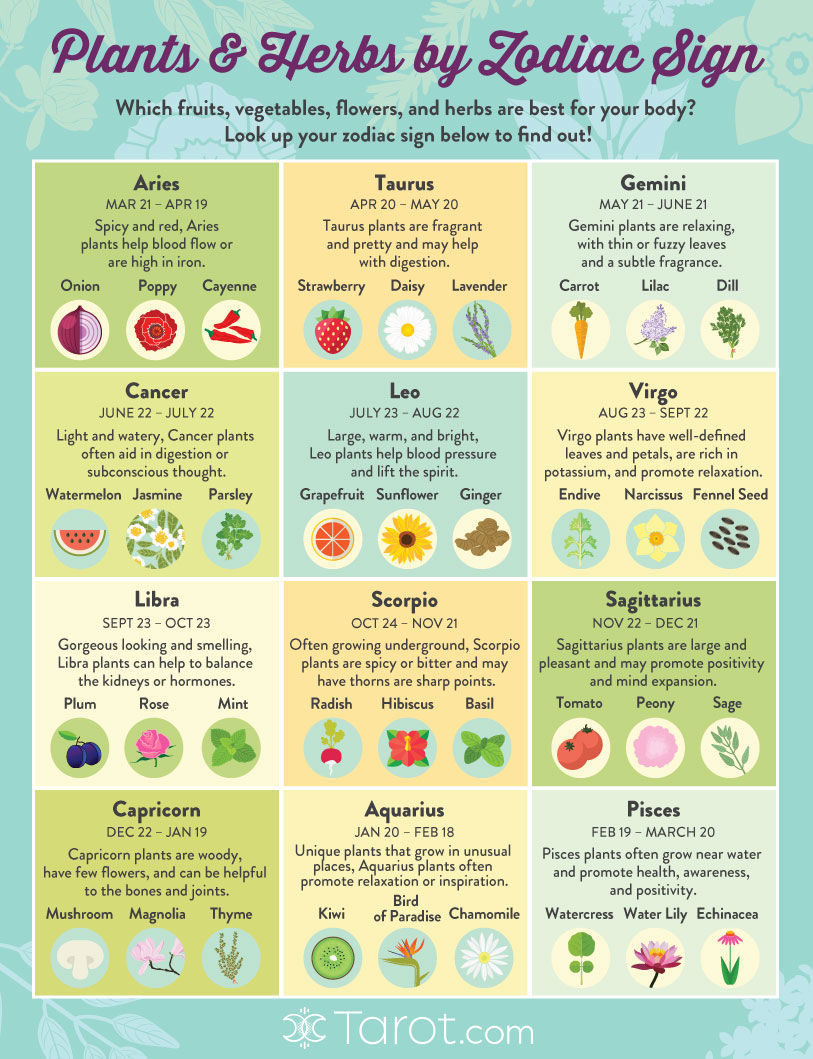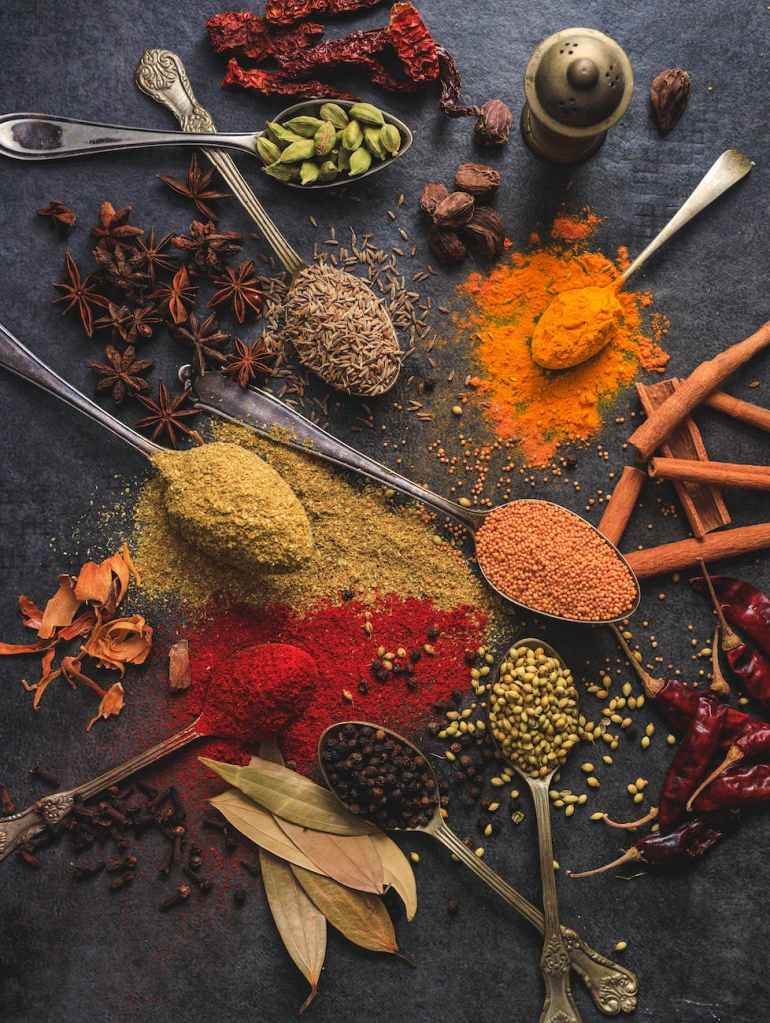Plants and Herbs for Your Zodiac Sign
An astrological guide to the benefits of Mother Nature
Which plants, herbs, fruits and vegetables are most helpful to YOUR zodiac sign? Each of the 12 signs can benefit from the properties of certain plants, which help to heal, grow, balance, and inspire. Look up your sign below and thrive by filling your garden, refrigerator, and home with these brilliant gifts from Mother Nature!

Aries (March 21 – April 19)
Aries is a Fire sign ruled by the planet Mars. Plants associated with this element and planet usually have thorns or prickles. They are also spicy or bitter in flavor or are red in color. Because Aries rules the head, eyes and face, the best plants for Aries are those that purify the blood, stimulate the adrenal glands, or are high in iron (Mars rules the mineral iron).
Fruits and Vegetables: Chinese cabbage, mustard, horseradish, onion, garlic, leeks, red pepper, rhubarb, chives, radishes
Flowers: Calendula, geranium, anise hyssop, poppies, red roses, tulips, amaryllis, hollyhock, cowslip, tiger lily, impatiens
Herbs: Nettles, burdock root, cayenne, red clover, yellow dock, yarrow, St. John’s wort, hops, marjoram, milk thistle, wormwood, gentian, sarsaparilla, tarragon, ginger, coriander
Taurus (April 20 – May 20)
Taurus is an Earth sign ruled by the planet Venus. Venus is the planet that represents desire and beauty, so Taurus plants often have gorgeous flowers and enticing fragrances. Because Taurus rules the throat and ears, the best plants for the Bull are often soothing to the throat, or may calm the digestive system after overindulging in the finest foods.
Fruits and Vegetables: Spinach, peas, potatoes, sweet potatoes, gourds, artichoke, olive, grape, apple, fig, apricot, pomegranate, strawberry
Flowers: Daisies, lilac, aster, lily of the valley, sweet pea, lilies, larkspur, columbine, violet, foxglove, rose, sweet William, daisy, geranium
Herbs: Licorice, fenugreek, slippery Elm, anise hyssop (Venus), mallow, lavender, dandelion, marshmallow, sage, vervain, feverfew, thyme, angelica, yarrow
Gemini (May 21 – June 20)
Ruled by the planet Mercury, Gemini is an Air sign that rules the lungs, shoulders, arms, and hands.
Gemini’s plants usually feature finely divided leaves or stems (like the bronchi of lungs), hairy or fuzzy leaves (related to the cilia in the lungs), or subtle odors. Plants associated with Gemini help to strengthen the lungs and respiratory system, or relax the nervous system.
Fruits and Vegetables: Endive, carrots, parsnips, oats
Flowers: Orchid, chrysanthemum, lilac, azalea, daffodil, Lily-of-the-valley, honeysuckle
Herbs: Mullein, hyssop, lemon balm, lobelia, elecampane, vervain, woodbine, yarrow, meadowsweet, dill, fennel, skullcap, lavender, fenugreek, licorice, valerian
Cancer (June 21 – July 22)
Because Cancer is a Water sign and is ruled by the Moon, Cancer’s plants generally have soft or Moon-shaped leaves, contain a lot of moisture, or are found near water. Oftentimes they are white in color, or have white or pale yellow flowers. Cancer rules the stomach, breasts, diaphragm, and liver, so plants that aid digestion or affect the subconscious are associated with the sign of the Crab.
Fruits and Vegetables: Brussels sprouts, broccoli, cabbage, cauliflower, endive, kale, lettuce, watercress, kohlrabi, mushroom, turnip, sweet potato, cantaloupe, cucumber, gourds, watermelon, pumpkin, squash, seaweed, mango, banana, apple, pear
Flowers: Daisy, water lilies, jasmine, hyssop, morning glory, geranium, lily, lotus, white roses, opium poppy
Herbs: Peppermint, spearmint, papaya leaf, agrimony, lemon balm, parsley, verbena, chickweed
Leo (July 23 – Aug. 22)
Naturally, Leo is a Fire sign ruled by the brilliant Sun. The part of the body ruled by Leo the Lion is the heart. Leo’s plants are usually large and gold or orange in color, or have heart-shaped leaves or a radiating shape. Plants that regulate blood pressure and have an uplifting effect on the spirit are most beneficial to Leo.
Fruits and Vegetables: Chinese cabbage, corn, collards, mustard, Swiss chard, okra, peppers, pineapple, orange, grapefruit, olive, coconut
Flowers: Marigolds, anise hyssop, sunflower, dahlia, larkspur, aster, passion flower, heliotrope, poppy, peony, calendula, crocus
Herbs: Borage, hawthorn, motherwort, rosemary, celandine, mint, lavender, parsley, dill, fennel, chamomile, St. John’s wort, angelica, eyebright, anise, ginger, saffron
Virgo (Aug. 23 – Sept. 22)
Virgo is an Earth sign ruled by the planet Mercury. Virgo is traditionally the Goddess of the Grain, and is associated with autumn. Her plants often have finely divided leaves or stems, subtle odors, or small, brightly-colored flowers. The most beneficial plants for Virgo are high in potassium and help to calm the nerves.
Fruits, Vegetables and Grains: Endive, carrots, parsnips, barley, oats, rye, wheat, millet
Flowers: Narcissus, chrysanthemum, aster, violet, all brightly colored small flowers (particularly blue or yellow)
Herbs: Dill, fennel, blackberry (leaves and root), plantain, St. John’s wort, skullcap, woodbine, valerian, lavender, marjoram, licorice, parsley, fenugreek, dill
Libra (Sept. 23 – Oct. 22)
Libra is an Air sign, and is ruled by the planet Venus. Because Venus is the planet of beauty and love, Libra’s plants often have light, lovely flowers and gorgeous scents. Libra rules the kidneys and the adrenals, so her plants help to bring balance to these areas of the body.
Fruits and Vegetables: Broccoli, eggplant, spinach, peas, sweet potato, artichoke, watercress, pomegranate, apricot, apple, fig, plum, grape, strawberry, olive
Flowers: Orchid, gardenia, tea roses, tuberose, freesia, gladiolus, aster, hydrangea, daisy, nasturtium, rose, violet, primrose, pansy, columbine
Herbs: Parsley, cleavers, juniper, corn silk, uva ursi, mint, thyme, yarrow, angelica, vervain
Scorpio (Oct. 23 – Nov. 21)
A Water sign ruled by both Mars and Pluto, Scorpio’s plants are often found in remote places or underground. They will likely have thorns, be red in color, and grow under adversity. The reproductive organs are ruled by Scorpio, so plants that balance the hormones, regulate the menstrual cycle, or help with childbirth and pregnancy are very beneficial to Scorpio.
Fruits and Vegetables: Mushroom, peppers, rhubarb, leek, onions, chives, pepper, garlic, horseradish, radish, mustard
Flowers: Calendula, rhododendron, geranium, holly, black-eyed Susan, scarlet monkey flower, anemone, heather, gardenia, honey-suckle, peony, hibiscus
Herbs: Aloe vera, ginseng, pennyroyal, raspberry leaf, saw palmetto, cramp bark, basil, gentian, wormwood, ginger, coriander
Sagittarius (Nov. 22 – Dec. 21)
Sagittarius is a Fire sign that is ruled by the planet large and optimistic planet Jupiter. So the Archer’s plants tend to be large in size and fairly conspicuous, with a pleasant odor. The best plants for Sagittarius will support the liver, are high in the mineral silica, and promote a positive frame of mind.
Fruits and Vegetables: Asparagus, endive, rhubarb, beets, tomato, turnip, watercress, olive
Flowers: Red roses, calendula, anise hyssop, pinks, carnations, clematis, peony, crocus, jasmine
Herbs: Dandelion, horsetail, Oregon grape root, wild yam, sage, feverfew, sage, anise, nutmeg, mint
Capricorn (Dec. 22 – Jan. 19)
As an Earth sign ruled by the planet Saturn, Capricorn’s plants usually have few flowers, are knobby or woody, and may have an unpleasant smell or taste. Saturn rules plants with long lives and slow growth, so plants with annual rings are also associated with the Goat. And because Capricorn rules the knees, joints, bones, and teeth, plants that are high in calcium can be very beneficial.
Fruits and Vegetables: Spinach, mushroom, beets, parsnips, barley, rye
Flowers: Calendula, black poppy, henbane, nightshade, African violet, snowdrop, jasmine, love-lies-bleeding, pansy, baby’s breath
Herbs: Comfrey, sarsaparilla, rue, kava kava, mullein, thyme, horsetail, shepherd’s purse
Aquarius the Water Bearer (Jan. 20 – Feb. 18)
Aquarius is an Air sign ruled by odd-ball Uranus, so the Water-bearer’s plants will often grow in unusual places and may vary in appearance. The most healing and beneficial plants for Aquarius are ones that help circulation, relax the nervous system, or promote inspiration.
Fruits and Vegetables: Spinach, beets, rye, barley, parsnip
Flowers: Bird of paradise, orchid, gladiolus, trillium
Herbs: Chamomile, catnip, skullcap, passion flower, valerian, hops, aloe, myrrh, frankincense, spikenard, kava kava, comfrey, cinnamon, cloves
Pisces the Fish (Feb. 19 – March 20)
As a Water sign ruled by both Jupiter and Neptune, Pisces plants are often large but hard to find, and may grow near the ocean. The most healing plants for Pisces are those that strengthen the immune system or have an antibacterial effect. Pisces plants may also catalyze expanded states of awareness and be helpful in dream work.
Fruits and Vegetables: Asparagus, endive, mushroom, rhubarb, beets, tomato, seaweed, watercress, olive
Flowers: Calendula, anise hyssop, jasmine, lilac, narcissus, water lily, poppy, clematis, wisteria, lilac, orchid
Herbs: Golden seal, Echinacea, chaparral, eyebright, mugwort, kava kava, yarrow, skullcap, oatstraw, nutmeg, anise
Tarot.com is Part of Zappallas USA © 2019
















You must be logged in to post a comment.